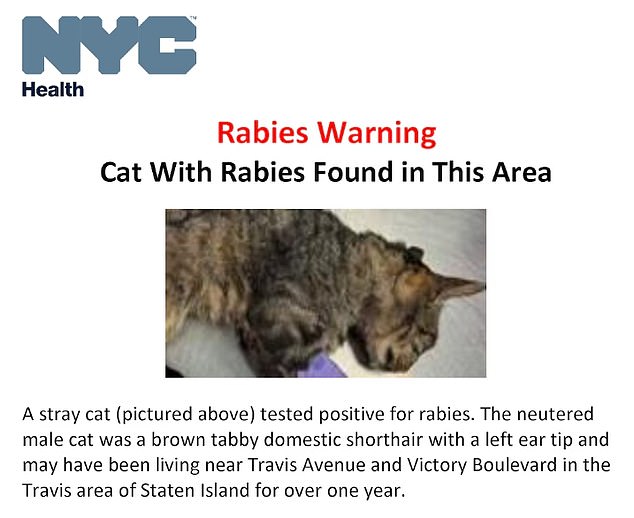Officials raise rabies alerts in US after people in multiple states are attacked by rabid raccoons, bats
Officials are warning Americans to be on the lookout for rabies-infected animals after a series of attacks in some parts of the country.
This month, a rabid raccoon attacked two dogs and rabid bats were found in two separate homes in Missouri.
Last month, a person in Staten Island, New York, was attacked by a stray cat with rabies, while in Massachusetts a rabid coyote attacked two people in a park.
And earlier this year, another raccoon with rabies attacked amusement park goers in Pennsylvania in March, and in February a Rhode Island hiker had to strangle a rabid coyote as it tried to claw him and his dog.
There are signs that rabid animals are more prevalent than normal in some parts of the country, with health officials particularly concerned about bats.
The map above shows which animals in certain areas are most likely to be infected with rabies

A stray cat with rabies attacked people on Staten Island, New York last month
Despite the increase in the number of rabid animals, officials have not reported that rabies infections in humans are increasing.
Health officials in South Carolina warned about rabies, saying, “It is critical to know that people, especially children, can be bitten by a bat without knowing it. That’s because bats have small teeth.’
Statistics show that fewer than 10 people become infected with the disease every year. Most infections are prevented by a shot that people receive after being exposed to suspected rabid animals. This prevents them from becoming infected with the virus.
Those suspected of being infected should receive one dose within 24 hours, then three more injections on days three, seven and 14 after their first vaccination.
Rabies is more than 99 percent fatal.
Dr. Thomas Moore, an infectious disease expert in Kansas, told DailyMail.com that he has seen more people concerned about rabies in recent years — but not more cases.
“It’s rare that someone is diagnosed with rabies,” he said, “and when it does happen, it’s sensational: people hear about it.”
“Normally, when there is an unprovoked animal attack, people are concerned about it and may get the rabies vaccine.”
Unprovoked animal attacks are a warning sign of rabies because the disease causes animals to approach and be aggressive toward others of any species, including humans.
Dr. Moore said he has had three rabies-related calls so far this year, which is normal for this time of year.
Overall, more than 90 percent of rabies cases nationally are linked to exposure to wildlife – with about a third linked to bats and another third linked to raccoons.
For example, a bat that is active during the day and is found on the ground, or appears unable to fly, should be treated as if it has rabies, according to officials with the Illinois Department of Public Health (IDPH).
People contract the virus through the saliva of infected animals that ends up in open wounds.
“If you have been bitten by an animal, seek medical attention immediately,” the IDPH said in an alert in May.
“Bite wounds can become infected and if the animal is at high risk for rabies, preventative treatment should be provided as soon as possible,” they noted.
Additionally, officials said that, whenever possible, residents “should not kill or release the bat before calling your doctor or local health department to help determine if you may have been exposed to rabies and need preventive treatment.”
A captured specimen could help local health officials determine treatment for exposed individuals, they added.
Many may not realise they have been infected, with it taking up to three months for the early warning signs of the illness – flu-like symptoms and unexplained tingling – to appear.
Within a week of these symptoms appearing, patients progress to the fatal form of the disease, which affects the brain and spinal cord and causes seizures, hallucinations and excessive salivation.
Nearly all patients who develop a rabies infection die from the disease, which has a mortality rate of 99.9 percent.
But in rare cases, several people have survived after doctors put them into a medically induced coma. The first person to survive the disease was Jeanna Giese of Wisconsin, who was bitten by a bat in a church in 2004.
North Carolina officials warned about rabies and reported seeing an increase in calls from people who had seen sick raccoons.
“Contact with wild animals is the main way people, pets and livestock become infected with rabies,” they said.
‘You can reduce the risk of rabies for yourself and your pets by avoiding contact with wild animals and taking some simple precautions.’
In Missouri, authorities are warning about bats that could be infected with rabies and reminding people to avoid direct contact with wild animals.
The warnings were particularly urgent given the recent emergence of baby bats – which may be lingering in homes and increasing the risk of infection.
